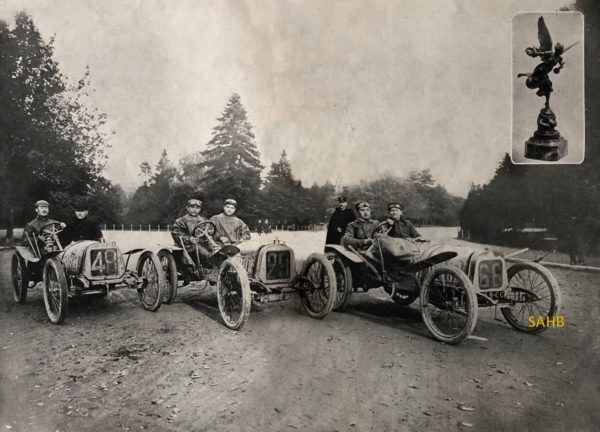
From 1905 to 1913 the French motoring magazine L’Auto organised a competition for Voiturettes called La Coupe de l’Auto or La Coupe des Voiturettes.
By 1906 the race had become a week-long “tourism competition”, to circumvent continuing ACF restrictions on pure racing. The 1906 and 1907 events were run on a road circuit at Rambouillet on the south-west outskirts of Paris and both were won by Siziare et Naudin cars.
But the rules also favoured the less glamorous but commercially equally lucrative ‘Regularity Cup’ – and this was won by a team of three Lion-Peugeot cars in both 1906 and 1907. As the reporter from La Vie au Grand Air remarked after the 1907 event: “It seems that Peugeot and regularity are synonymous.” Our Snapshot shows the three cars and drivers at the 1907 event, with the cup itself in the top right-hand corner of the picture.
The reporter should not have used the word Peugeot on its own, because these were Lion-Peugeots – a name that deserves some explanation. The Peugeot company had been making cars since 1890, but serious expansion into car manufacture required investment on a scale that would turn the company away from its traditional products, in particular the bicycles produced since 1882.
Eugène Peugeot opposed this investment in car manufacture, and his second cousin Armand left to form Automobiles Peugeot. The cousins signed an agreement that gave Armand’s business the sole right to manufacture Peugeot cars, and kept Eugène solely in the business of making bicycles, tricycles and quadricycles, some with motors and some without.
By 1905 control over Eugène’s original business had passed to his three sons, Robert, Pierre and Jules, who desperately wanted to produce cars. They therefore agreed to pay a million francs annually to Armand Peugeot, to allow them from 1906 to manufacture their cars under the Lion-Peugeot name.
The 1907 cars in our Snapshot are VC models, single-cylinder 1,045cc machines of 8.5 horsepower, with chain drive. From left to right the drivers are Jules Goux (3rd), Giosué Giuppone (6th) and Stéphane Duvernoy (9th).
The report of the event placed great emphasis on the importance of reliability to the normal everyday driver, and stressed that these were not specially-prepared racing cars but chassis that were on sale to the public.
Lion-Peugeot cars sold well: over 1,000 of the original VA model between 1905 and 1908, and 1,000 of these VC models between 1906 and 1910.
With the death of Eugène in 1907 the two parts of the family were reconciled, and the businesses merged in 1910, with the name Lion-Peugeot being reserved for smaller models in the Peugeot range.
Photo courtesy of The Richard Roberts Archive.







Leave a Comment